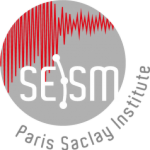Context
The vulnerability assessment of civil engineering structures under seismic loading is one of the central points of the reduction of the seismic hazard impact on ordinary residential buildings, commercial buildings (or related to civil-security), or industrial plant buildings involving a “special risk” such as the nuclear industry. Possible failures built up an input in the probabilistic seismic hazard analysis, for both buildings and equipments placed therein. Vulnerability must be analysed during the design stage and also during periodic reassessments, where a detailed analysis is required: geometry of building structures, material behaviour…
Objectives
The R&D axes are:
- Understand the physical phenomena regarding the structures behaviour under seismic loading (nonlinearities, laws of bahaviour of local and complex materials on a global sclae, damping from several dissipative physical phenomena…), based on an experimental approach (structural elements, models representing overall 3D structures) by means of the TAMARIS platform at CEA and of different scales modelling.
- Develop and validate models, notably used as a predictive tool in probabilistic approaches (conditional probability of failure and fragility curves), based on data obtained by experience, to identify damage criteria and the sensitivity in function of the models and the laws of behaviour used. Numerical simulations requir nonlinear transient analyses which are generally computation time consuming; that is why modelling at a global scale is developed from the local description in order to process the structures of complex industrial buildings.
The current research actions are mainly focued in modeling the behavior of concrete and reinforced concrete under seismic loading. Indeed, these materials are essential constituents of many civil engineering structures.
Models for concrete under seismic loading
During the last fifty years, the scientific community has become aware not only of the interest but also of the difficulties of formulating constitutive models of concrete under cyclic loadings. In 1991, the first uniaxial model of concrete appears. Although still widely used today, they are not sufficient when local information (crack width, tortuosity, etc..) are sought. Recently, a constitutive framework alowing to take into account the main dissipation mechanisms has been developed. This has been recognized as having interesting properties. However, an identification of the unilateral effect (crack closure effect) should be conducted. Issues related to unilateral effect criterion, its description and its formulation, remain currently open and adressing them is clearly an expectation of the scientific community as well as a need from the industrials.
In the framework of the SEISM Institute, a research project is conducted on the identification of unilateral effect. This project is based on a dual approach combining discrete and continuous model. Indeed, the discrete approach should help to provide local information on the mechanism of crack closure such that the criterion of reclosing (yield stress, deformation threshold, energy threshold, etc..). The set of identified information will then be incorporated in a continuous model in order to make computation on structures of large scale.
This work will improve the understanding of nonlinear phenomena and lead to a macroscopic model of concrete behavior.

Modeling of reinforced concrete under seismic loading
A major component of civil engineering construction is reinforced concrete. Modeling the behavior of reinforced concrete introduced an additional level of complexity with respect to the modeling of concrete. Indeed, it is necessary to take into account the interaction between steel and concrete and the degradation of steel. The aim of various work within the SEISM institute is the development of structural element models integrating these mechanisms, e.g. energy dissipation (Christelle Combescure’s Thesis – EDF) and providing local information such as cracking (Ejona Kishta’s Thesis – CEA et ENS Cachan).

For computational efficiency reasons, the developed models do not take into account all dissipative phenomena. To improve them, it is possible to enhance the numerical damping introduced in the simulations. The experimental and numerical characterization of the damping of structures under earthquake is part of the objectives of the SEISM Institut (Romain Crambuer’s Thesis – ENS Cachan).
